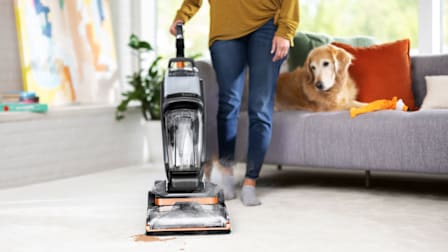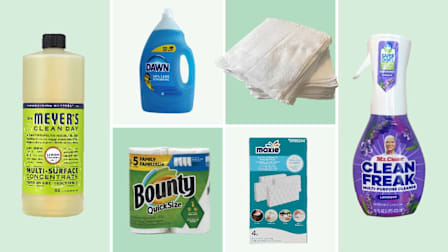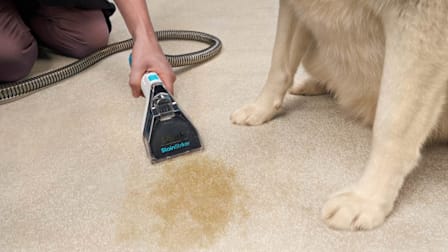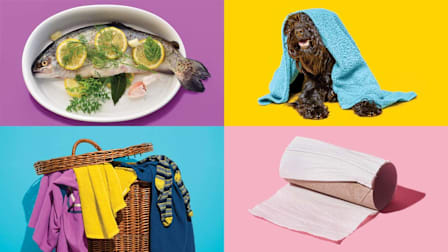5 Things to Know Before Buying a Carpet Cleaner
Bigger and more expensive carpet cleaners don’t necessarily clean better. Here’s what to look for in your carpet cleaner.
When you shop through retailer links on our site, we may earn affiliate commissions. 100% of the fees we collect are used to support our nonprofit mission. Learn more.
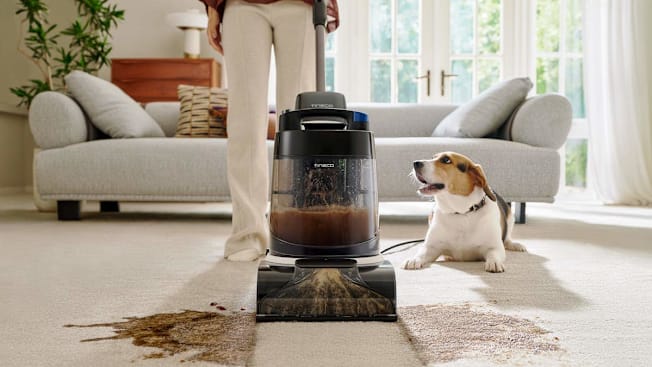
If the floors in your home are covered in carpet and there are lots of feet (or paws) to make a mess of it, a great carpet cleaner may be a wise addition to your cleaning arsenal. It can make short work of muddy paw prints and stains like red wine spills or years of accumulated dust and soil in a way that even the best vacuums can’t.
What to Know Before Buying a Carpet Cleaner
The carpet cleaners currently in our ratings cost from $100 to $700. Remember that while the more expensive deep cleaners are twice as big, they don’t necessarily clean twice as well.
Here are a few things to keep in mind as you shop:
Carpet cleaners are heavy when empty and even heavier after you fill them with cleaning solution. A full tank adds 6 to 15 pounds to the full-sized models in our ratings—and you’ll have to lug it from the sink, too.
On each model page, we list the carpet cleaner’s weight when empty and when full. Of course, a handle makes it easier to carry your machine around, so look for a model that has one if heft is a concern.
You should check the tank setup, settings, accessories, and cord and hose lengths. Some carpet cleaners have only a single tank with one chamber for the fresh solution and another for the spent mixture. But we found that it’s more convenient to have two separate tanks, one for water and the other for the cleaning solution. Some have dispensers that automatically add the cleaning agent to the water, saving you the hassle of having to measure out a full tank each time.
As for settings, some manufacturers claim that their models clean hardwood or tiled floors as well as carpets. There are also carpet cleaners that have dry-only settings so that you can suck up more water after your initial cleaning, which may speed up drying time.
When it comes to accessories, an independently rotating brush tends to scrub more aggressively than a fixed brush (or no brush at all). Some models offer a variety of tools for special applications, including upholstery, small stains, pet stains, stairs, and corners and crevices.
A longer cord and a hose can save you some repositioning effort. The models currently in our ratings typically have cords that are 20 to 22 feet, but some run as long as 25 feet. A hose is especially useful for cleaning stairs, upholstery, and other tough-to-reach areas. “If your stairs have carpeting, you’ll want a longer hose to reach up the steps,” Ciufo says. “And remember, these machines are heavy. You don’t want your machine falling down the stairs after you tug the hose too far.” Of the cleaners we’ve tested that have hoses, they tend to be 8 to 9 feet long, though a few models, particularly deep cleaners, come with longer hoses.
The standard solution is fine for most cleaning. Manufacturers recommend that you use their proprietary cleaning solution with their machines—even requiring it, at the risk of voiding the warranty. And they might sell a bewildering array of specialized solutions. Hoover, for one, offers a dozen choices for carpets and floors.
But for routine carpet cleaning, specialty formulas and spot-stain removers aren’t necessary. Save the specialized solutions for stubborn stains, like a pet mess.
Carpet cleaners are loud. An average vacuum cleaner can produce up to 70 decibels of noise. A carpet cleaner is much, much louder. In our tests, the average noise level was 80 dBA. (In decibels, a reading of 80 is twice as loud as 70.) At this decibel level, we recommend wearing hearing protection, especially if you’re using the machine for a prolonged period. So grab noise-canceling headphones or earplugs that guarantee protection for up to 85 dBA. (Check out these tips for preventing hearing loss.)
Cleaning with a carpet cleaner takes time. A vacuum can come out of the closet ready to go. But a carpet cleaner? Not so much. First, you have to move furniture out of the area you plan to clean. Then, you should vacuum the carpet. Next, fill the machine with cleaning solution and water.
When using a carpet cleaner, you push and pull it just like a vacuum. Push the carpet cleaner out to arm’s length, then pull it back while continuing to squeeze the trigger. For a dry cycle, release the trigger and complete the same steps.
To suction the cleaning solution from the rug, make dry passes with the carpet cleaner. If the carpet is still dirty, repeat wet and dry passes until the cleaning solution you removed from the carpet runs clear. Once you’re satisfied, you’ll need to let the carpet dry completely before you (or your pets) walk on it or you put the furniture back.
After admiring your work, you have to unplug the machine, clean out the tank, and remove any debris from the brushes following the instructions in your owner’s manual.
Best Carpet Cleaners
Here are the best carpet cleaners based on our latest tests.
How CR Tests Carpet Cleaners
We put each carpet cleaner through a battery of cleaning performance tests. To assess both full-sized and portable carpet cleaners, our engineers soil large swatches of off-white nylon carpet with red Georgia clay, and then run a cleaner over the carpet for four wet and four dry cycles, simulating how you’d clean a particularly dirty spot on a well-trafficked carpet. Then they repeat the test on two more swatches.
During the test, our experts use a colorimeter, a device that measures the absorption of light wavelengths, to take 60 readings of each carpet per test: 20 in its clean state, 20 after it’s been soiled, and 20 after it has been cleaned. Sixty readings each on three swatches make a total of 180 readings per model. Based on how much color is left, we score how well the carpet cleaner has removed the soil for our cleaning score.
We do a similar test to assess drying performance, applying a set amount of water to carpet swatches and running a dry pass with each carpet cleaner over the carpets. Our testers measure the weight of the wet carpet and the weight of the carpet after it’s been “dried” with the cleaner (the cleaners don’t fully dry the carpet, but the good ones can pick up a decent amount of water), and assign drying scores depending on how much water the cleaner picks up.
We also evaluate how loud each carpet cleaner is by taking readings in decibels and sones. The scores for convenience are based on factors such as the cleaner’s weight, the capacity of its water tanks, and the number of additional attachments that come with it.
In our carpet cleaner ratings, you’ll notice that the scores for portable carpet cleaners are lower than almost all of the scores for full-sized models. That’s because we put the portables through the same rigorous tests as the full-sized cleaners, tests designed to evaluate how well a carpet cleaner can extract deeply embedded soil from a carpet. But portable carpet cleaners are really designed for a different job: spot-cleaning smaller stains. So while their scores are low compared with full-sized models, they’ll perform much better on the kinds of messes they’re designed for.





























